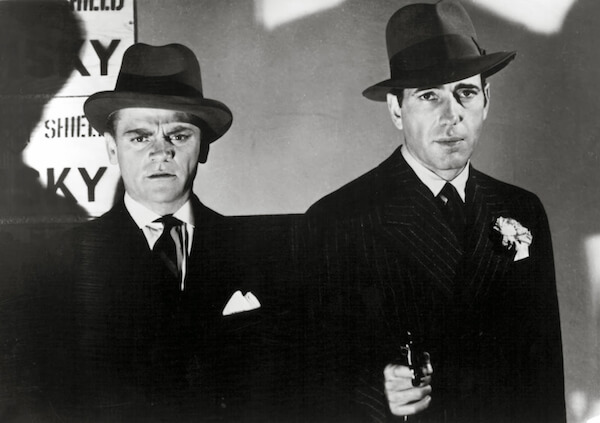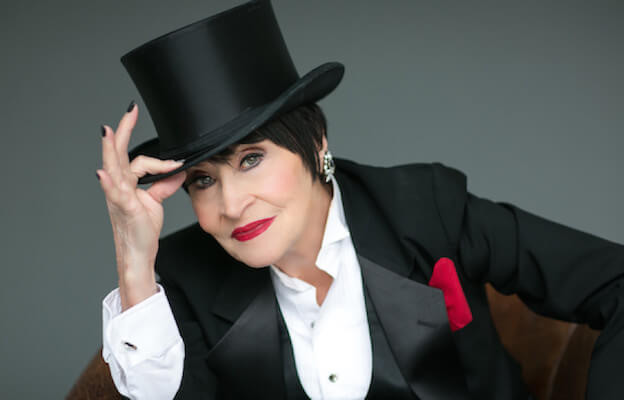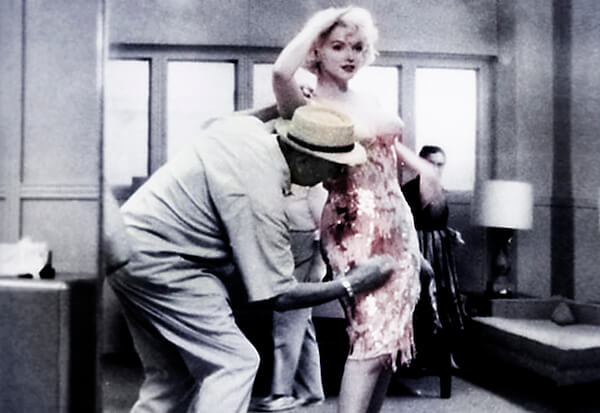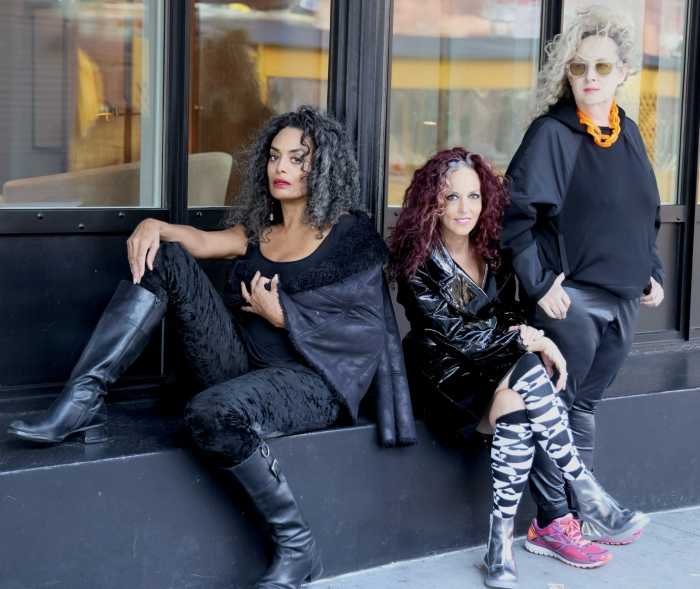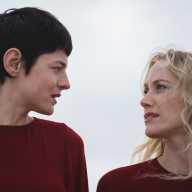Kelly Moore and Elizabeth Fuller in Fuller’s “Me and Jezebel,” at Snapple Theater through October 26. | CAROL ROSEGG
Bette Davis — often called the greatest of film actresses (most serious rival: Katharine Hepburn) — drives me crazy. It is true that she could be brilliant (“Of Human Bondage,” “Dangerous,” “Marked Woman,” “Jezebel,” “Dark Victory,” “The Old Maid,” “The Letter,” “Now Voyager,” “All About Eve,” “Baby Jane”), but in too many movies she coasted on those familiar mannerisms of emphatic, staccato delivery, semaphore gesticulation, and sheer brass that have made her beloved by female impersonators for eons. Handled correctly, she could have made a great Blanche DuBois, Hedda Gabler, or Mary Tyrone, but, instead, did mediocre soap operas, chose weak directors she could control, and botched great opportunities like “The Little Foxes” and “The Corn is Green” because of her predictable and all-too-easy interpretive choices. God knows I adore her, but how, in her own words, she IR-ritates me!
Can you imagine having her for a houseguest? Elizabeth Fuller actually hosted her for what was supposed to be a couple of nights and turned into 32 days, which she has dramatized in her play “Me and Jezebel,” now playing at the Snapple Theater (210 W. 50th St., through Oct. 26; snappletheater.com). In it, Bette (Kelly Moore) makes Blanche DuBois look like the model lodger as she takes over Fuller’s house, driving her hostess’ husband to the point of desertion and turning her four-year-old son into an unseemly clone of herself.
I met with Fuller and Moore, and Fuller recalled, “It really happened in 1985, and this started as a book in 1992. It became very popular, especially among the gay community. Now it’s an e-book and I don’t even have one copy of it!
The diva stays (and stays), Tautou’s “Thèrése, Ollom Festival magic
“My husband always said, ‘Nothing beats you in our living room telling dinner guests what it was like.’ I had sent the manuscript to a producer I knew and he said he would like to see it as a play. So I wrote it as a one-person show and played myself around the country. Then I saw Randy Allen do his show, ‘P.S. Bette Davis,’ and told him, ‘Why don’t you play Bette in my show?’ and rewrote it as a two-hander.
“My best friend, Robin Brown, was Bette’s best friend, and asked if she could bring a friend to dinner without telling me who it was. The next day, Bette called and said there was a New York hotel strike and could she spend the night because she really liked our very simple but quaint cottage. She stayed for 32 days, and my husband, John G. Fuller, was kind of a male Bette, except he couldn’t stand her, never a fan, and all he wanted was to get her ass out of there.”
Moore said he was always a Bette fan, watching “The Million Dollar Movie” on TV while growing up on Long Island.
“I came to New York at 17, auditioned, and got a part in the revival of ‘Life with Father’ in 1967, with Sandy Duncan, Leon Ames, and Dorothy Stickney, the mother in the original production written by her husband, Howard Lindsay. I learned a lot about acting from her. She did the same thing every night, identically, yet it always looked like the first time she’d ever done it!”
Fuller explained, ”Kelly was doing my show in Key West, sent me a video, and I was blown away. They were casting for it in Kansas and were going to use a woman because they said the Bible Belt audiences wouldn’t accept a man in the role. After two days, I said, ‘I think you should call Kelly.’ They reluctantly flew him out and hired him, and then he did it in Australia. The show’s been running a long time in several countries — Sao Paolo, Berlin, Prague, Warsaw, Japan soon. It’s an easy two-person show and who doesn’t love Bette?”
Moore said, “It took a long time to figure out how to play this. Initially I said, ‘If you want it to be like “wink-wink! This is a man in drag,” forget it.’ I wanted to approach it from reality, wondering how far to take it to keep it real but also funny. Then I saw Bette’s pilot of her unsold sitcom and suddenly knew how to do it!”
Moore doesn’t emphasize Davis’ stroke because he tried to do that voice: “I bored myself to death because it was so monotone.” Jim Bailey had done the role in Key West, and Fuller found him good, “but he brought it to a camp level, which was fun, but really not the story. Kelly is playing it more of a cross between ‘Dead Ringer’ and post-stroke, but everything in there is true.
“Even though Bette did hobble, after 10 minutes she had such vitality you didn’t even think stroke with her. I inherited things she left Robin in her will — her pearl and sapphire ring, which Kelly wears in the play [along with her ‘Whales of August’ earrings the actor bought at Christie’s], and the ‘All About Eve’ mink coat. I had it in my basement and the rats must have gotten to it. It’s in pieces now but I’ve made them into ear muffs, one of which I’m giving to Broadway Cares, and on Halloween we’re having a Bette lookalike contest and the winner will get a pair, as well!”
Audrey Tautou in Claude Miller’s Thérèse Desqueyroux,” which opens at the Angelika on August 23. | MPI PICTURES
One role that Bette would have been born for was Thérèse Desqueyroux, titular heroine of François Mauriac’s brilliantly corrosive novel, which was brought to the screen by Claude Miller, his swan song (opens Aug. 23 at the Angelika, 18 W. Houston St. at Mercer St.; angelikafilmcenter.com). It’s a gripping, perfect adaptation in every way. You won’t see a better film this year, and the lead is definitively played by Audrey Tautou, an actress hitherto known more for her gamine charm than ability to portray a stifled bourgeois wife and would-be murderess.
“Yes,” the deeply thoughtful actress told me, looking miraculously no older than her 2001 title role in “Amélie.” “This is a different character from what I’ve played before — darker and more complex. Even though the book is a very popular French classic, I hadn’t read it, but Claude Miller told me to read it before I read his script to know the character. We had wanted to work together for a long time, and he’d had the chance to make this before, but he wanted the right person, so, luckily, he waited for me.
“I did not read the sequel to the book because when I do a movie adapted from a novel, I really want to focus on the director’s vision and not make any compromise between that and whatever books there may be. It’s very sad that it’s his last movie. I really liked the fact that he never judges any character, only the hypocrisy of the conventions of family, the invisible violence which is the real monster of the story.
“Like you, I actually find Thérèse sympathetic, because she’s a victim. It’s not her fault that she did not know herself so well and thought this bourgeois marriage would be her ideal. She didn’t have the bravery to say no, and there’s this social pressure which makes her become a criminal.
“She soon realizes that she is not ready for this life, stuck in this wealth. It’s terrible to have this awareness that you are in a tunnel and if you don’t do something, you will spend rest of your life in this darkness. For me, she is not a monster and, yes, is a little like Madame Bovary, with that complete boredom but also the fascination of a crime, doing something totally with no morals.
“Claude would send me texts from other writers which had an echo to this violence of the bourgeoisie, and we agreed and had the same vision about this story. With him, nothing was ever overdone in his quest to find the truth of the story and the humanity of his characters.”
The costuming may also be the most perfect of the year, “very simple too. We didn’t have a big budget — no money to make clothes — so all the clothes are vintage.”
When I told Tautou that she was almost unrecognizable as Thérèse, she said, “I think I’m a much more complex person than what I show when I’m doing Chanel promotions or the romantic comedies I did when I was younger. I loved them, but the truth is I am not only the cute girl and have something much more dark and complex.
“When I auditioned for ‘The Da Vinci Code,’ Ron Howard had seen every French actress except me because I think he had a certain image of me. Then he told me he had seen me on ‘Charlie Rose’ and thought maybe he should audition me. One has to have the opportunity to stretch oneself in a different way.”
Tautou enjoyed being the face of Chanel “because I had a lot of freedom in my contract and only had to do a few promotional things each year. But now my contract is up — Brad [Pitt] took my job!”
“Amélie” remains iconic in her career with its cult status and Montmartre tours of the film’s locales: “I think it’s a miracle how people keep loving this movie and it goes through the years without losing its charm. It’s a real gift and, yes, my parents did name me after Audrey Hepburn. First, because they loved the name and they also loved her. I do too — she was the most elegant!”
I went for the first time to Northampton, Massachusetts, famed dyke capital of America, for the Ollom Art Festival, created by dancer and choreographer John Ollom and his partner, Jim Sable, and absolutely adored it. It’s the home of all-female Smith College, a veritable paradise for lesbians and like a wonderful, alterna-universe of gorgeous, blissed out estrogen of all ages, sizes, and color — with Victorian buildings in sylvan surroundings providing the dream backdrop.
I caught a remarkable Sylvia Plath exhibit in the college library, detailing the writing of “The Bell Jar,” and marveled at the holdings in its museum, which include the greatest Cezanne I’ve ever seen (a worthy gift from the artist to Renoir). My host was retired New York City schoolteacher Roberta Pato, whose avocation is the compiling of lesbian stories on film and TV and each night screened a new, wondrous rarity for me from her Ali Baba archive (“The Chinese Botanist’s Daughter,” “I, Worst of All,” “The Secret Diaries of Miss Anne Lister”).
The festival itself was a kaleidoscope of intense works, all using art as therapy, Ollom’s particular credo. Opening night saw his new dance piece “Prisoner of My Projection” at the gorgeous Academy of Music. With the long-tressed Ollom the center of a male love triangle, flanked by two comely, contrasting brunettes (talented Jeffrey Carr and Matthew Stone), it was a mysterious, beautifully staged, potent exposé of male sexuality and emotional conflict. Sparked by wonderfully evocative music from Yael Acher-Modiano and a fabulously fulsome sexuality featuring full nudity, it’s Ollom’s best work to date.
It was followed by “C’est Moi: Women in Translation,” a contrastingly lighthearted investigation of a lesbian relationship, choreographed and performed by real life partners Tory Rosen and Diana Alvarez. Serious charmers, these two not only danced but sang and left the entire house smiling with delight.
Contact David Noh at Inthenoh@aol.com and check out his blog at nohway.wordpress.com.





